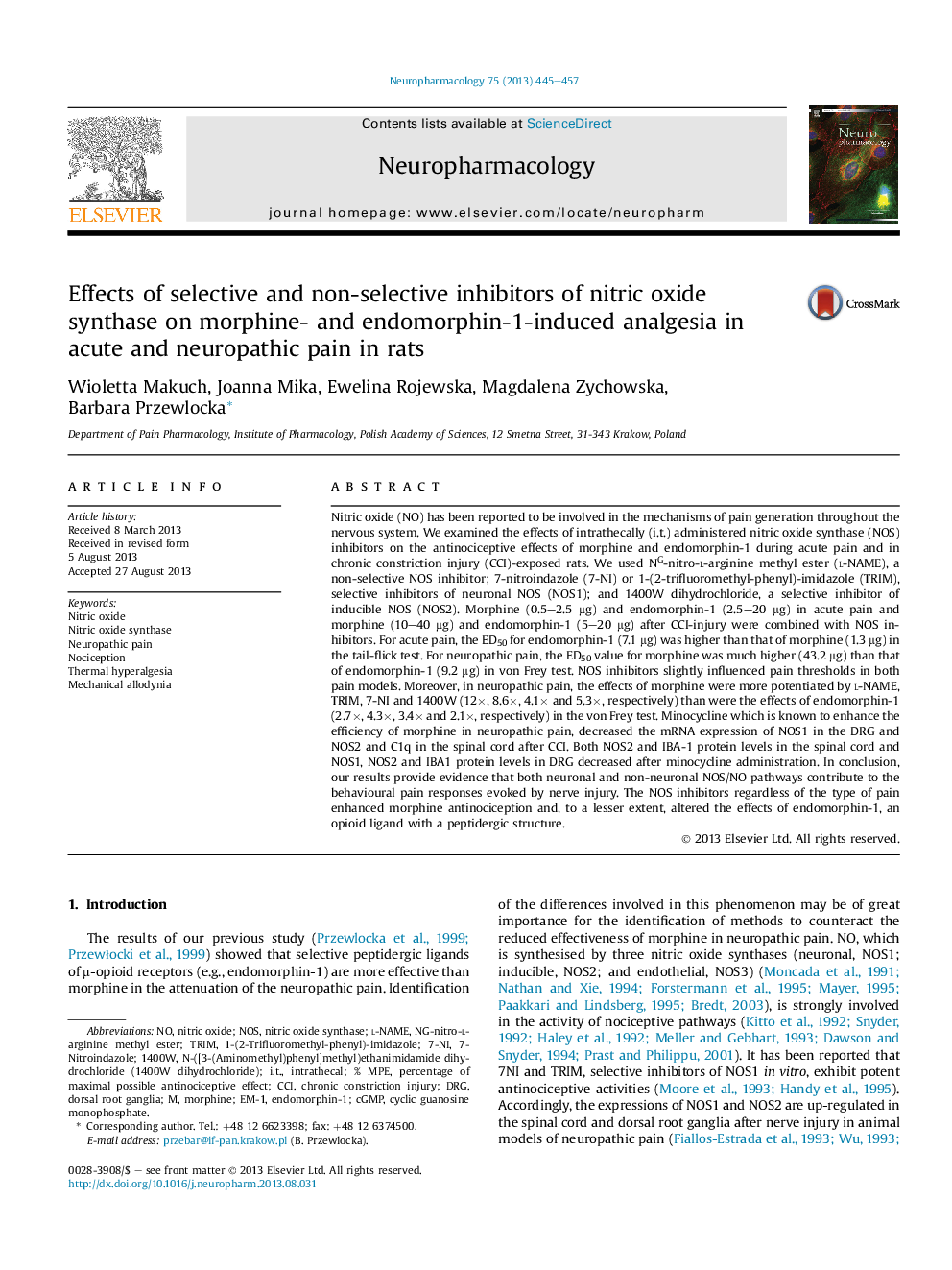| Article ID | Journal | Published Year | Pages | File Type |
|---|---|---|---|---|
| 2493380 | Neuropharmacology | 2013 | 13 Pages |
•In acute pain, the ED50 of endomorphin-1 is higher than that of morphine (∼6×).•In the CCI model, the ED50 of morphine is higher (∼6×) than that of endomorphin.•In the CCI model, NOS inhibitors more efficiently potentiated morphine analgesia than endomorphin analgesia.•In the CCI model, minocycline decreased NOS1, NOS2 and C1q mRNA levels and NOS1, NOS2 and IBA-1 protein levels.•Both neuronal and non-neuronal NOS/NO pathways contribute to neuropathic pain.
Nitric oxide (NO) has been reported to be involved in the mechanisms of pain generation throughout the nervous system. We examined the effects of intrathecally (i.t.) administered nitric oxide synthase (NOS) inhibitors on the antinociceptive effects of morphine and endomorphin-1 during acute pain and in chronic constriction injury (CCI)-exposed rats. We used NG-nitro-l-arginine methyl ester (l-NAME), a non-selective NOS inhibitor; 7-nitroindazole (7-NI) or 1-(2-trifluoromethyl-phenyl)-imidazole (TRIM), selective inhibitors of neuronal NOS (NOS1); and 1400W dihydrochloride, a selective inhibitor of inducible NOS (NOS2). Morphine (0.5–2.5 μg) and endomorphin-1 (2.5–20 μg) in acute pain and morphine (10–40 μg) and endomorphin-1 (5–20 μg) after CCI-injury were combined with NOS inhibitors. For acute pain, the ED50 for endomorphin-1 (7.1 μg) was higher than that of morphine (1.3 μg) in the tail-flick test. For neuropathic pain, the ED50 value for morphine was much higher (43.2 μg) than that of endomorphin-1 (9.2 μg) in von Frey test. NOS inhibitors slightly influenced pain thresholds in both pain models. Moreover, in neuropathic pain, the effects of morphine were more potentiated by l-NAME, TRIM, 7-NI and 1400W (12×, 8.6×, 4.1× and 5.3×, respectively) than were the effects of endomorphin-1 (2.7×, 4.3×, 3.4× and 2.1×, respectively) in the von Frey test. Minocycline which is known to enhance the efficiency of morphine in neuropathic pain, decreased the mRNA expression of NOS1 in the DRG and NOS2 and C1q in the spinal cord after CCI. Both NOS2 and IBA-1 protein levels in the spinal cord and NOS1, NOS2 and IBA1 protein levels in DRG decreased after minocycline administration. In conclusion, our results provide evidence that both neuronal and non-neuronal NOS/NO pathways contribute to the behavioural pain responses evoked by nerve injury. The NOS inhibitors regardless of the type of pain enhanced morphine antinociception and, to a lesser extent, altered the effects of endomorphin-1, an opioid ligand with a peptidergic structure.
Graphical abstractFigure optionsDownload full-size imageDownload as PowerPoint slide
